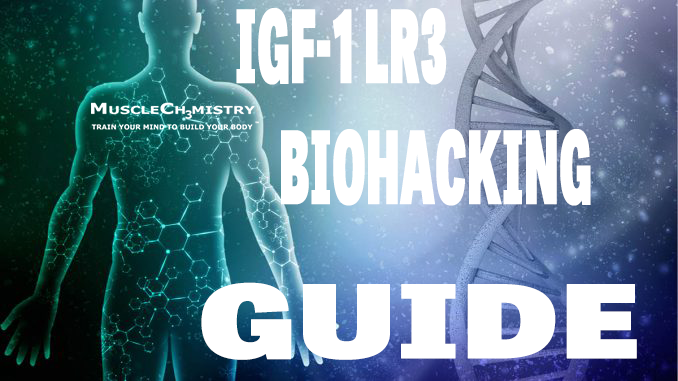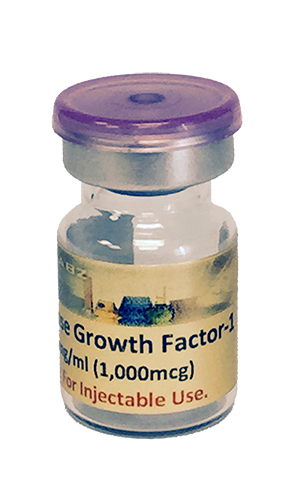IGF-1 LR3 Guide To Understanding Why It Belongs In Your Cycle
IGF-1 LR3 is a highly revered more bioavailable version of the muscle building hormone IGF-1. Due to its unique structure, this makes it a potent supplement to stimulate protein synthesis and help you increase lean muscle mass, reduce body fat and recover quicker from intense training sessions.
IGF-1 LR3 (Also known as Long arginine 3-IGF-1 and LR3-IGF-1) Is a more bioavailable version of the muscle building hormone Insulin-like Growth Factor 1 (IGF-1). IGF-1 LR3 possesses an arginine instead of a glutamic acid at the third position in its amino acid sequence. It also contains 83 amino acids instead of 70, which is found in IGF-1. This is what makes IGF-1 LR3 a highly revered peptide.
IGF-1 LR3’s Benefits include
- Improved Athletic Performance
- Increases Lean Muscle Mass
- Improved Recovery
IGF-1 LR3 History
IGF-I LR3 was developed in the 90’s by Australian Biotech company, GroPep. Its potency is due to its ability to bind to IGF-1 receptors with the same affinity as IGF-1, though has a reduced binding that allows its biological actions not to be disrupted compared to IGF-1. This results in better IGF-1 receptor signalling activity even at much lower concentrations. [1]
IGF-1 LR3 Benefits
The benefits for any athlete using IGF-1 LR3 is due to its’ ability to mimic IGF-1 and stimulate protein synthesis for increased lean muscle mass.

Pro Bodybuilders and IGF-1 lr3
IGF-1 is similar in structure to the blood sugar hormone insulin. IGF-1 levels are barely detectable at birth and start to rise during childhood as its primary responsibility is growth. Its levels peak mid-puberty until around age 40 and then declines gradually.
IGF-1 production is reliant on stimulation of Human Growth Hormone (HGH) from the pituitary gland into the bloodstream. This then triggers the liver to produce IGF-1, which allows it to exert its effect on virtually every tissue in the body.
HGH & The IGF-1 Process
When IGF-1 and HGH are working synergistically, then your body has an ability along with the right nutrition and training to become an effective all singing and dancing machine that can increase lean muscle mass, reduce body fat and allow you to recover quicker.
Muscle Growth
Protein synthesis is one of the most fundamental biological processes of muscle growth. So to achieve optimal results is a dynamic process of protein breakdown and protein synthesis. This is where IGF-1 plays an integral role. Research at The University of Cincinnati and Shriners Burns Institute in Ohio have shown IGF-1 not only to be effective at increasing muscle protein synthesis but also at inhibiting protein breakdown. [2]
This is because IGF-1’s encourages the uptake of amino acids into the body. Research at The Medical School of Nanjing University in China has shown that intake of Essential Amino Acids is important for regulating the IGF-1 system and its anabolic effects. [3]
IGF-1 Intense Weight lifting
When it comes to exercise, high-intensity training is the most effective at stimulating IGF-1 release. Research has shown that intense weight training is an important stimulus for a natural release of IGF-1 in muscle for growth and strength gains. [4]
Furthermore, research has shown that IGF-1 LR3 not only supports the growth and retention of existing muscle, it also promotes the growth of new muscle. [5]
Fat Loss
For athletes looking to become leaner and reduce body fat, your body’s ability to access glucose and fat for energy is an important factor. Research has also shown that IGF-1 is effective at increasing glycogen synthesis. During intense training bursts, it will allow your body to become more efficient at burning energy, allowing you to maintain higher intensities for longer. [6]
IGF-1 lr3 Fatloss
Furthermore, IGF-1 LR3 is effective at mobilizing fat for energy. Research has shown that it prevents insulin from transporting glucose across the cell membrane. This forces the cells to use fat as a source of energy. [7]
Recovery
Where IGF-1 shines for many athletes is in its ability to help them recover post workout and especially after injuries. IGF-1’s main benefit is its ability to decrease inflammation. Researchers at Tel Aviv University in Israel found that low IGF-1 levels were associated with chronic inflammation. [8]
Furthermore, research has shown that IGF-1 improves the healing process of collagen and nerve tissue. [9]
IGF-1 LR3 Side effects
IGF-1 lr3 & Diabetics – Low Blood Sugar
The most common side effect of IGF-1 LR3 is hypoglycemia (low blood sugar). To reduce your risk of this, it is recommended to consume food for 15-20 minutes, specifically protein and a mixture of simple and complex carbohydrates before administering your IGF-1 LR3.
If you experience any symptoms of hypoglycemia such as dizziness, sweating, palpitations or drowsiness, it is recommended to consume simple sugars and continue to consume them until the symptoms go away.
IGF-1 LR3 Dosage
*Popularly Recommended Dosing Guidelines for IGF-1 LR3
The recommended dosage is 20-40mcg, 1-2 times per day. Start with a lower dose and increase accordingly depending on response.
IGF-1 LR3 has a half-life of about 20-30 hours and is much more potent than IGF-1, so do not exceed 80-100mcg as you increase your risk of hypoglycemia.
Final Thoughts
Lean Muscle With IGF-1 lr3
Compared to steroids and testosterone, which offer users a faster burn regarding results, peptides like IGF-1 LR3 offer more of a medium burn, though without the potentially uncomfortable side effects that come with the former. This is why if your goal is to increase muscle mass, burn body fat, and improve muscle recovery then peptides are the best option.
Disclaimer: Peptide Hormones are banned by WADA and most other global sporting organisation for both in-competition and out-of-competition use. You should NOT use them if you are competing in any such sanctioned sport as it a prohibited class of anabolic agents. Please check with local doping agencies for the latest information.
*Popularly Recommended Dosing Guidelines are based on study and manufacturer information and are for informational purposes only. Always consult a doctor and follow manufacturer recommendations when taking any supplement.
References
- Human LR3 IGF-I (Receptor Grade) https://gropep.com/media/BAhbBlsHOgZmSSIhMjAxMi8xMi8xMi8xOV8yM18xMV8yMjhfZmlsZQY6BkVU/19_23_11_228_file Accessed on 12 September 2018
- Cheng‐Hui Fang MD Bing Guo Li MD Jing Jing Wang MD Josef E. Fischer MD Per‐Olof Hasselgren MD Insulin‐Like Growth Factor 1 Stimulates Protein Synthesis and Inhibits Protein Breakdown in Muscle From Burned Rats https://onlinelibrary.wiley.com/doi/pdf/10.1177/0148607197021005245 Accessed on 12 September 2018
- Xianfeng Xia, Xinying Wang , Qiurong Li, Ning Li, Jieshou Li Essential Amino Acid Enriched High-Protein Enteral Nutrition Modulates Insulin-Like Growth Factor-1 System Function in a Rat Model of Trauma-Hemorrhagic Shock https://journals.plos.org/plosone/article?id=10.1371/journal.pone.0077823 Accessed on 12 September 2018
- Daniel W. D. West and Stuart M. Phillips Associations of exercise-induced hormone profiles and gains in strength and hypertrophy in a large cohort after weight training https://www.ncbi.nlm.nih.gov/pmc/articles/PMC3371329/ Accessed on 12 September 2018
- Sundgren, Nathan & D Giraud, George & M Schultz, Jess & Lasarev, Michael & J S Stork, Philip & L Thornburg, Kent. Extracellular signal-regulated kinase and phosphoinositol-3 kinase mediate IGF-1 induced proliferation of fetal sheep cardiomyocytes https://www.researchgate.net/publication/5322402_Extracellular_signal-regulated_kinase_and_phosphoinositol-3_kinase_mediate_IGF-1_induced_proliferation_of_fetal_sheep_cardiomyocytes Accessed on 12 September 2018
- Marc U. Baumann, 1 Henning Schneider, 1 Antoine Malek, 1 Vidya Palta, 2 Daniel V. Surbek, 1 Ruth Sager, 1 Stacy Zamudio, 3 and Nicholas P. Illsley 3 Regulation of Human Trophoblast GLUT1 Glucose Transporter by Insulin-Like Growth Factor I (IGF-I) https://www.ncbi.nlm.nih.gov/pmc/articles/PMC4144961/ Accessed on 12 September 2018
- Biruhalem Assefa, 1 , 2 Ayman M. Mahmoud, 1 , 2 , 3 Andreas F. H. Pfeiffer, 1 , 4 Andreas L. Birkenfeld, 5 , 6 Joachim Spranger, 1 , 2 , 7 and Ayman M. Arafat Insulin-Like Growth Factor (IGF) Binding Protein-2, Independently of IGF-1, Induces GLUT-4 Translocation and Glucose Uptake in 3T3-L1 Adipocytes https://www.ncbi.nlm.nih.gov/pmc/articles/PMC5750484/ Accessed on 12 September 2018
- IliaBeberashviliaInnaSinuanibAdaAzarcHadasKadoshicGregoryShapiroaLeonidFeldmanaJudithSandbankbZhanAverbukha Decreased IGF-1 levels potentiate association of inflammation with all-cause and cardiovascular mortality in prevalent hemodialysis patients https://www.sciencedirect.com/science/article/pii/S1096637413000695 Accessed on 12 September 2018
- Paolo P Provenzano, corresponding author1 Adriana L Alejandro-Osorio,2 Kelley W Grorud,1,3 Daniel A Martinez,4,5 Arthur C Vailas,5 Richard E Grindeland,6 and Ray Vanderby, Jr1,3 Systemic administration of IGF-I enhances healing in collagenous extracellular matrices: evaluation of loaded and unloaded ligaments https://www.ncbi.nlm.nih.gov/pmc/articles/PMC1851714/ Accessed on 12



